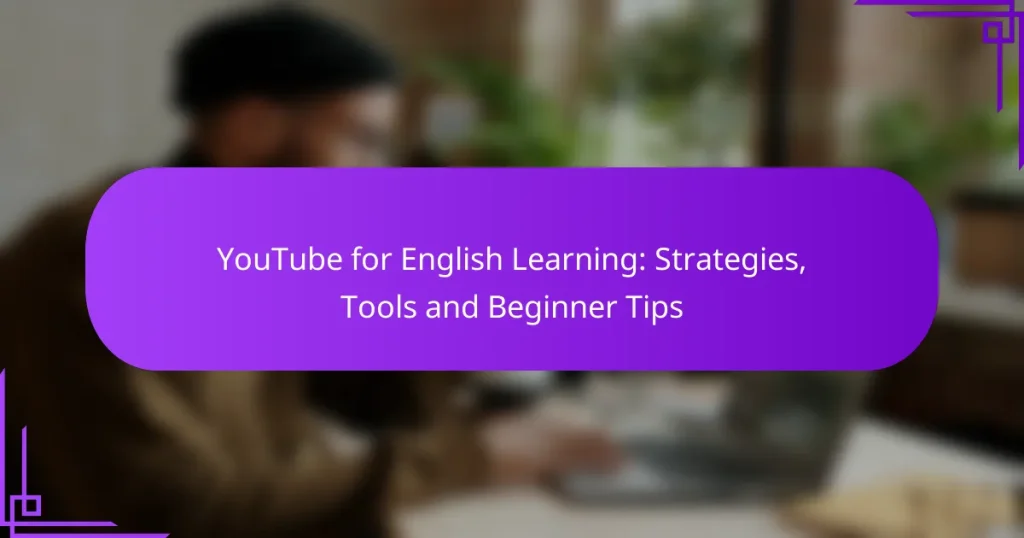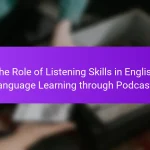YouTube is a powerful resource for English learners, offering a wide range of engaging content that caters to different proficiency levels. By leveraging effective strategies such as creating playlists, using subtitles, and following educational channels, learners can enhance their listening, speaking, and comprehension skills in a fun and interactive way.
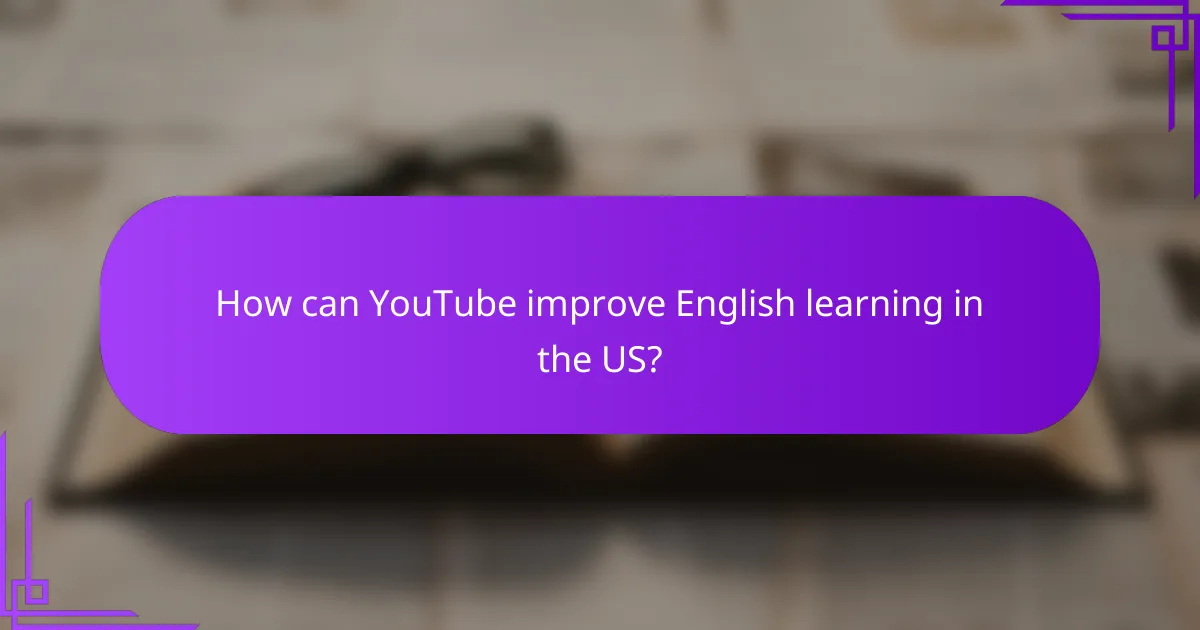
How can YouTube improve English learning in the US?
YouTube can significantly enhance English learning in the US by providing diverse and engaging content tailored to various proficiency levels. Its vast library of videos allows learners to practice listening, speaking, and comprehension skills in an interactive and enjoyable manner.
Engaging video content
YouTube offers a wide range of engaging video content, including tutorials, vlogs, and educational series that cater to different interests. This variety keeps learners motivated and helps them connect with the language in real-life contexts. For instance, watching cooking shows in English can teach culinary vocabulary while also improving listening skills.
Consider following channels that focus on language learning, such as English with Lucy or BBC Learning English, which provide structured lessons alongside entertaining content.
Interactive language challenges
Many YouTube creators host interactive language challenges that encourage viewers to participate actively. These challenges may involve repeating phrases, completing sentences, or even engaging in pronunciation exercises. Such activities can enhance retention and make learning more dynamic.
For example, channels might post weekly challenges where viewers submit their responses in the comments, fostering a sense of community and accountability.
Community support through comments
The comments section on YouTube videos can serve as a valuable resource for learners. Engaging with other viewers allows learners to ask questions, share insights, and receive feedback on their language skills. This interaction can help build confidence and provide additional practice opportunities.
To maximize this benefit, learners should actively participate in discussions, ask for clarification on difficult topics, and offer support to others in the community.
Access to native speakers
YouTube provides learners with direct access to native speakers from various English-speaking countries. This exposure helps learners understand different accents, slang, and cultural references that are essential for fluency. Watching native speakers in action can also improve listening comprehension.
Channels featuring interviews, travel vlogs, or everyday conversations are excellent resources for hearing authentic language use in context.
Variety of learning styles
YouTube caters to various learning styles, making it easier for individuals to find content that resonates with them. Visual learners can benefit from videos with subtitles and graphics, while auditory learners can focus on podcasts or discussions. Kinesthetic learners might enjoy interactive content that encourages movement or participation.
To effectively utilize this variety, learners should explore different types of videos and formats, such as animated lessons, live streams, or interactive quizzes, to find what works best for them.
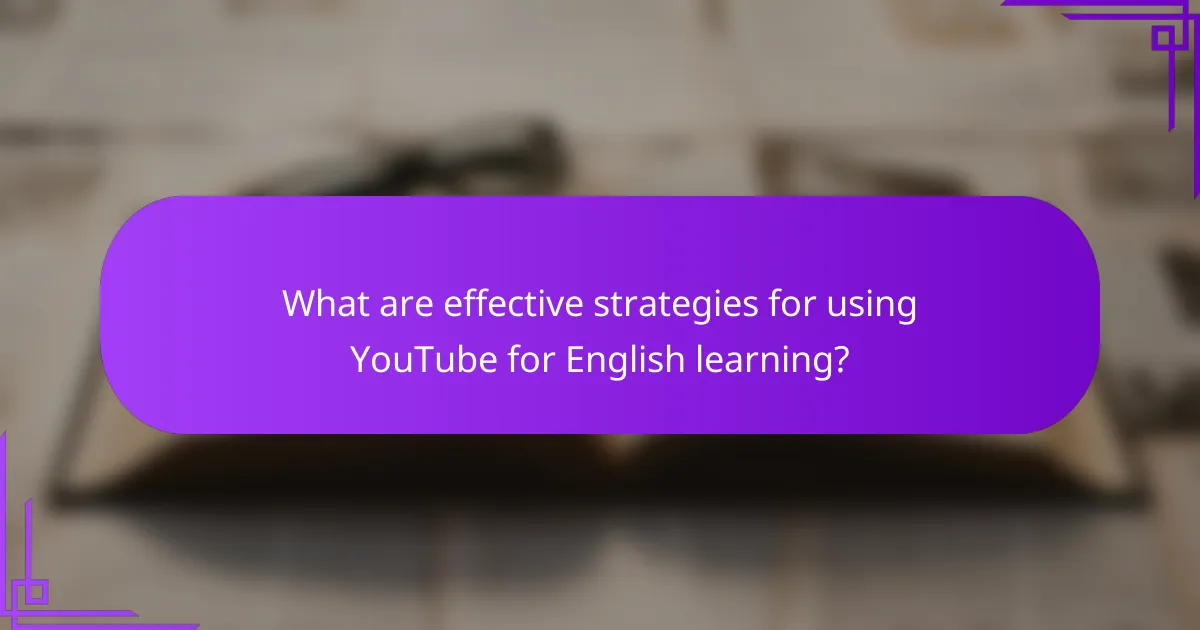
What are effective strategies for using YouTube for English learning?
Effective strategies for using YouTube for English learning include creating a dedicated playlist, utilizing subtitles, following educational channels, and participating in live sessions. These approaches enhance comprehension, engagement, and retention of the language.
Creating a dedicated learning playlist
Creating a dedicated learning playlist helps organize your English learning resources in one place. Select videos that cover various topics, such as grammar, vocabulary, and pronunciation, and arrange them in a logical order to facilitate progressive learning.
Consider adding new videos regularly to keep the content fresh and engaging. Aim for a playlist of around 10-20 videos to start, allowing for manageable viewing sessions without overwhelming yourself.
Using subtitles for comprehension
Using subtitles can significantly enhance your understanding of spoken English. Enable English subtitles on videos to follow along with the dialogue, which helps reinforce vocabulary and pronunciation.
As you become more comfortable, try switching to subtitles in your native language or turning them off entirely. This gradual approach can improve listening skills and boost confidence in comprehension.
Following educational channels
Following reputable educational channels can provide structured learning and diverse content. Look for channels that focus on English language learning, such as BBC Learning English or English with Lucy, which offer lessons tailored to different proficiency levels.
Engage with the content by taking notes or practicing exercises suggested in the videos. Aim to watch at least one video from these channels each week to maintain a consistent learning routine.
Participating in live sessions
Participating in live sessions can enhance your speaking and listening skills through real-time interaction. Many educational channels host live Q&A sessions or conversation practice, allowing you to engage directly with instructors and other learners.
To make the most of these opportunities, prepare questions in advance and actively participate by speaking up or typing in the chat. Aim to join at least one live session per month to build confidence and improve fluency.
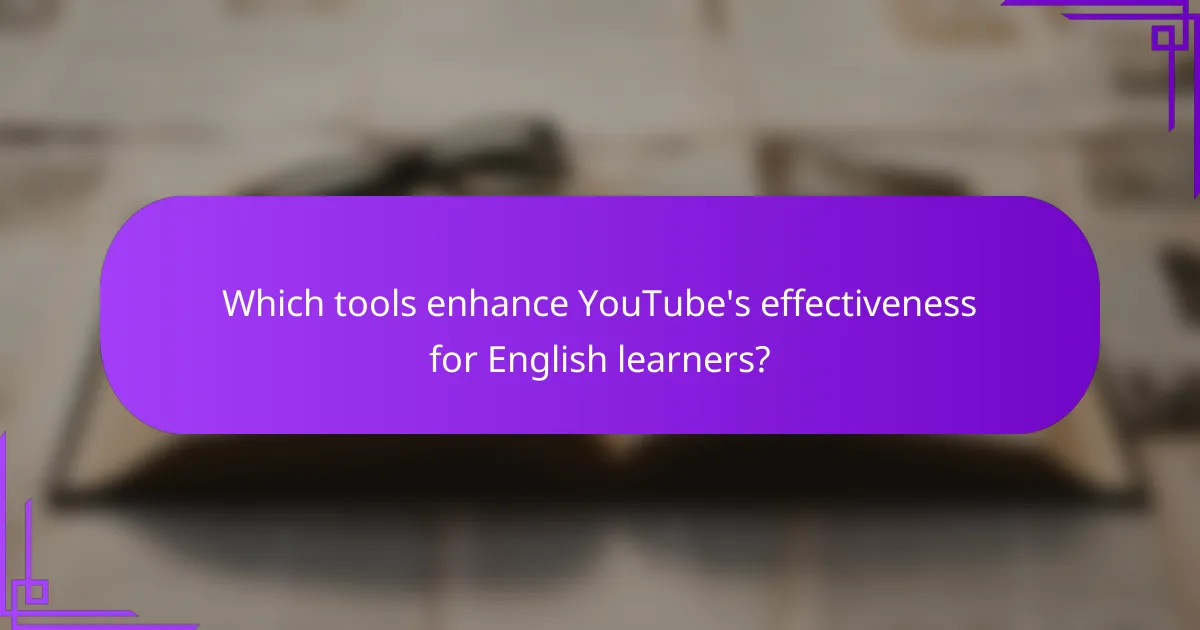
Which tools enhance YouTube’s effectiveness for English learners?
Several tools can significantly improve the effectiveness of YouTube as a resource for English learners. These tools facilitate language practice, enhance comprehension, and provide opportunities for interactive learning.
Language learning apps integration
Integrating language learning apps with YouTube can create a more immersive experience. Apps like Duolingo or Babbel often have features that complement video content, allowing learners to practice vocabulary and grammar in context.
For instance, after watching a video, learners can use these apps to reinforce what they’ve learned through interactive exercises. This combination helps solidify language skills and enhances retention.
Video editing tools for practice
Video editing tools can be a valuable asset for English learners looking to practice their speaking and comprehension skills. Programs like Adobe Premiere Pro or free options like Shotcut allow users to edit their own videos, which can include adding subtitles or voiceovers.
By creating their own content, learners can focus on pronunciation and fluency. This hands-on approach not only boosts confidence but also provides a practical application of language skills in a creative format.
Transcription services for videos
Transcription services can enhance understanding by providing written text of spoken content in videos. Tools like Otter.ai or Google Docs voice typing can automatically transcribe video audio, allowing learners to follow along more easily.
Using transcriptions, learners can identify new vocabulary and phrases, making it easier to revisit challenging sections. This method is particularly useful for advanced learners who wish to analyze speech patterns and improve their listening skills.
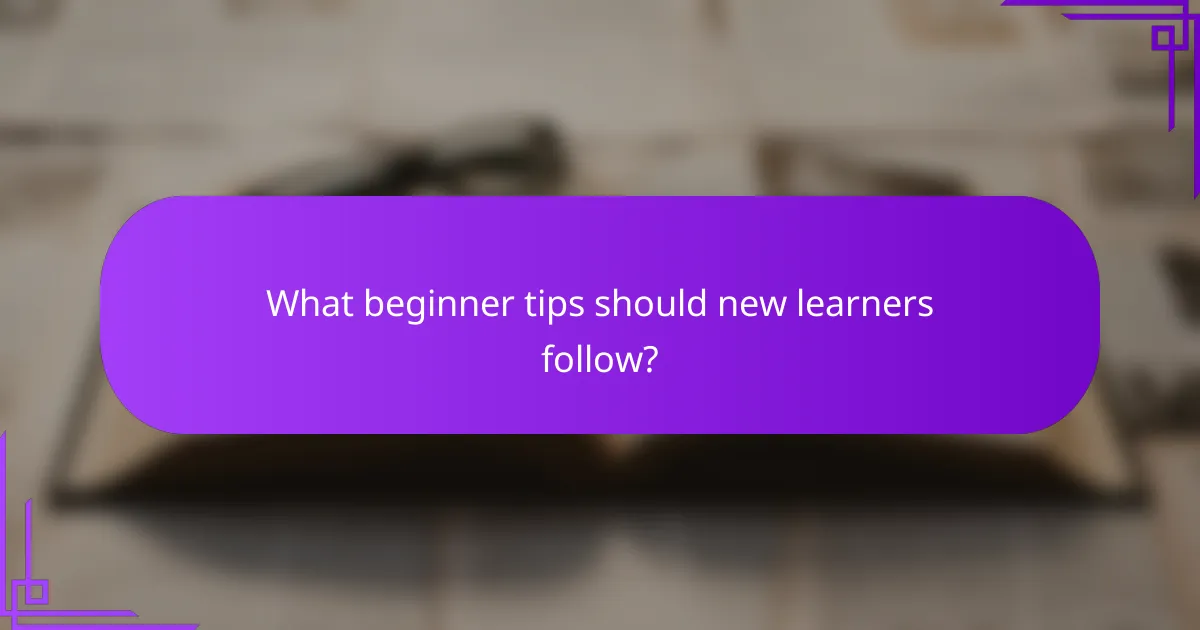
What beginner tips should new learners follow?
New learners should focus on practical strategies that enhance their English skills through YouTube. Key tips include selecting appropriate channels, setting realistic goals, practicing speaking, and actively engaging with the content.
Start with beginner-friendly channels
Choosing beginner-friendly channels is essential for new learners. Look for channels specifically designed for English learners, which often feature slower speech, clear pronunciation, and simplified vocabulary. Examples include “English with Lucy” and “BBC Learning English,” which provide structured lessons tailored for beginners.
These channels often categorize their content by skill level, making it easier to find videos that match your current proficiency. This targeted approach helps build a solid foundation before moving on to more complex material.
Set achievable learning goals
Setting achievable learning goals is crucial for maintaining motivation. Start with specific, measurable objectives, such as watching one English video daily or learning five new vocabulary words each week. This structured approach helps track progress and keeps you accountable.
Consider breaking larger goals into smaller milestones. For instance, aim to understand the main idea of a video before focusing on detailed comprehension. This method allows for gradual improvement without overwhelming yourself.
Practice speaking along with videos
Practicing speaking while watching videos can significantly improve your pronunciation and fluency. Try repeating phrases or sentences after the speaker to mimic their intonation and rhythm. This technique helps reinforce language patterns and builds confidence in speaking.
Consider using videos with subtitles to follow along more easily. As you become comfortable, challenge yourself by turning off the subtitles and relying on your listening skills. This progression can enhance your overall language abilities.
Engage with the content actively
Active engagement with video content is vital for effective learning. Take notes on new vocabulary or interesting phrases, and try to use them in your own sentences. This practice reinforces memory and encourages practical application of the language.
Additionally, participate in the comments section or discussion forums related to the videos. Engaging with other learners and native speakers can provide valuable feedback and foster a sense of community, enhancing your learning experience.
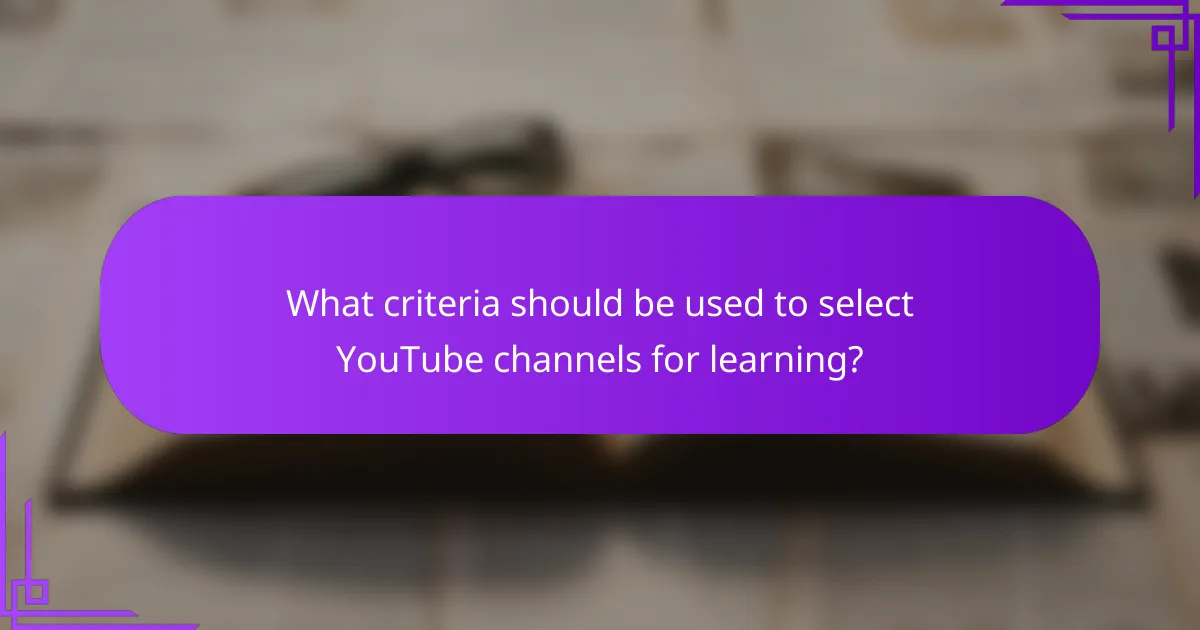
What criteria should be used to select YouTube channels for learning?
When selecting YouTube channels for learning English, focus on content quality, relevance to your learning goals, and the frequency of uploads. These factors ensure that the material is engaging, informative, and consistently available for practice.
Content quality and relevance
High-quality content is essential for effective learning. Look for channels that offer clear explanations, well-structured lessons, and engaging visuals. Channels should also align with your specific learning objectives, whether you want to improve vocabulary, grammar, or conversational skills.
Consider channels that provide a variety of formats, such as tutorials, quizzes, and real-life conversations. This diversity helps maintain interest and caters to different learning styles. Check viewer feedback and ratings to gauge the effectiveness of the content.
Frequency of uploads
The frequency of uploads can significantly impact your learning experience. Channels that post new content regularly, such as weekly or bi-weekly, keep learners engaged and provide fresh material to practice with. Consistency helps reinforce learning and encourages routine study habits.
However, prioritize quality over quantity. A channel that uploads less frequently but offers in-depth, well-produced content may be more beneficial than one that posts daily but lacks substance. Aim for a balance that suits your learning pace and keeps you motivated.
